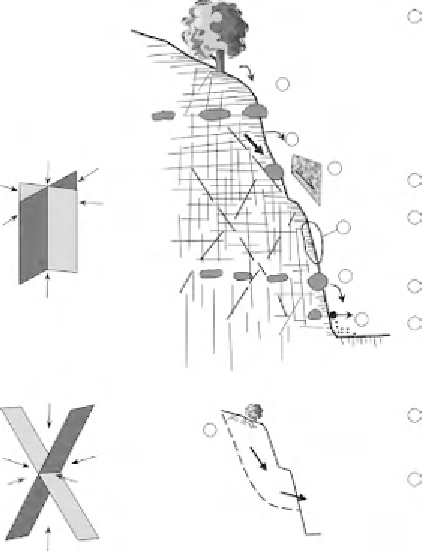Geology Reference
In-Depth Information
Hoek,2000), but the
first step would be to collect more empirical data on the way that the Po Chang
mudstone behaves regionally and to identify whether there are any large-scale failures that might be
back-analysed.
Ra
velling failure
Rapid weathering
(opening of bedding)
Undermining of boulders
/concretions
Not appropriate to
analyse numerically
-
observation of rate
1
Geological
concept for
joint styles in
slope
4
3
σ
1
σ
2
5
2
Boulder fall
σ
3
σ
3
Slab failure toppling
(contribution from root
jacking?)
3
1
σ
2
2
4
Tree fall
σ
1
seepage
7
Translational planar
we
dge failure
not observed at this site
but evident at coastal
exposure of same rock
Large scale failure mass
Diagenetic
burial
joints
5
σ
1
−
most joints & bedding not
adverse
6
6
Q? how to
define mass
strength?
σ
2
σ
3
7
Seepage backsapping
σ
2
σ
3
σ
1
Figure B6-5.3
Ground model for slope. Main discontinuities include bedding which is almost horizontal,
orthogonal near-vertical joints and steeply inclined shear joints. Potential failure mechanisms (1 to 7) are
field and by numerical analysis where possible.
The simplest type of analysis is undrained in which it is assumed that
the soil has a uniform strength, independent of stress level, expressed as
cohesion along the potential slip plane. The logic is that any change in
normal stress is matched by a change in water pressure so that change
in effective stress and frictional resistance is zero. This type of analysis is
only appropriate for earthworks in clay, immediately after cutting, and
is not considered further here (see also
Box 6-3 r
e pile design).
More generally an effective stress analysis is used where the strength
of the soil (or closely fractured rock) is considered to be derived from
two components
-
friction and cohesion, as per the Mohr-Coulomb
expression:
τ ¼ðσ
−
uÞ
tan
ϕ þ c






